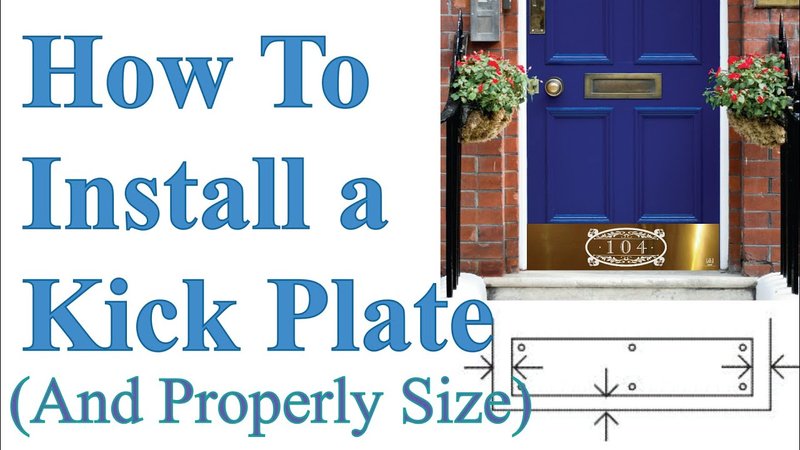
If you’ve ever wished for that smooth, professional finish you see on fancy front doors, there’s a way: install a kick plate with concealed screws. It sounds tricky, but with a little patience and the right approach, even a beginner can get that crisp, clean look. Whether you’re sprucing up a classic oak door or a modern steel one, brands like National Hardware and Schlage make these hidden-mount plates surprisingly accessible. Let me walk you through it—think of it as hiding the seams on a really good magic trick.
Why Choose a Kick Plate With Concealed Screws?
You might be wondering, “Aren’t all kick plates basically the same?” Not quite. The traditional kick plate has visible screws right on top. Sure, it gets the job done, but those little dots can look out of place, especially if your door is otherwise sleek or painted a bold color. With a concealed screw kick plate, the hardware is hidden behind the plate, giving you a flush, unbroken surface.
This clean look isn’t just about aesthetics. Concealed screws can also help your kick plate last longer, since they’re less likely to catch on shoes, pet fur, or daily grime. If you’re already detail-oriented with home projects—or you’re just tired of doors that look like a patchwork—you’ll definitely appreciate the difference. Honestly, it’s like swapping visible band-aids for invisible, seamless protection.
Plus, kick plates with concealed screws are often just as sturdy as regular ones. Brands like National Hardware design them to fit snugly and stay secure even after years of use. You won’t be giving up durability for that sleeker style. It’s an upgrade that’s both good-looking and practical, especially if you’re already planning to pair or reset your other home fixtures for a cohesive style.
What Tools and Materials Do You Need?
Before you start, gather everything you’ll need—it keeps things smooth and stress-free. Here’s what to have on hand for most installs:
- Kick plate with concealed screw design (make sure it fits your door size and type)
- Drill and bits (typically 1/8″ or whatever the manufacturer recommends)
- Measuring tape
- Painter’s tape or masking tape
- Level
- Pencil (for marking spots)
- Phillips screwdriver
- Safety glasses
Most concealed screw models use a mounting track or code-matched bracket system, so check the packaging—sometimes there are included templates or even a tiny level right in the box. If you’re syncing the look with existing door hardware, double-check the metal finish (brass, brushed nickel, black, etc.) so it resets the vibe instead of clashing.
How Do Concealed Screw Kick Plates Work?
The trick to concealed screw kick plates is in their clever installation method. Basically, instead of screwing directly through the face of the plate, you mount a hidden bracket or track onto the door. The front plate then snaps, slides, or pairs onto that track, hiding all the screws behind it. It’s kind of like a battery cover on a remote—only nobody can tell it’s removable.
Different brands use slightly different techniques. For example, National Hardware often uses a track that you screw to the door, then the plate clicks or slides over. Schlage’s kit might include adhesive strips for extra hold, or even a little code marking to make alignment easier. No matter the method, the goal is the same: strong attachment, zero visible screws, and a kick plate that feels like part of the door, not an afterthought.
You might think it takes special tools or advanced skills to pair all this hardware correctly, but honestly, it’s more about patience and following instructions step by step. The only thing you really want to avoid is rushing or skipping the level—crooked plates are way harder to reset than to just get right the first time!
Step-by-Step Guide: Installing a Kick Plate With Concealed Screws
Here’s the part where you actually make the magic happen. Take it slow and don’t stress—if you’ve ever assembled furniture or synced up a TV remote, you’re more than ready.
- Step 1: Line Up the Kick Plate. Hold the plate where you want it, usually centered along the bottom edge of your door. Use painter’s tape to temporarily hold it in place. Make sure it’s level before marking anything.
- Step 2: Mark Drill Holes. Mark the hole locations using a pencil through the mounting bracket or template (often included). Double check spacing—if you’re troubleshooting a warped or battered door edge, measure from multiple points.
- Step 3: Drill Pilot Holes. Put on your safety glasses and use the appropriate drill bit to make small pilot holes at each mark. This step keeps the screws from splitting the door or wandering off-track.
- Step 4: Attach the Mounting Track. Secure the mounting track or bracket with the provided screws. Don’t overtighten—you want them flush, but not so tight you strip the wood or metal.
- Step 5: Snap or Slide on the Face Plate. Align the kick plate with the bracket and fit it in place. Some designs use a slide-on motion, others press or snap on. If adhesive is provided, peel and stick as directed to finish the install.
Take your time at each step. If something doesn’t fit right or the plate feels loose, backtrack and check alignment before you move on.
When you step back, you’ll see a smooth, secure kick plate—and not a single screw showing. That’s the whole point of this approach: maximum protection, minimum visual fuss.
Common Problems and How to Troubleshoot
Even with clear instructions, things don’t always go perfectly the first time. Here are some common issues and how to reset or fix them:
- The plate won’t snap in place: Check that the mounting track is fully seated and not upside down. Reset the alignment and gently try again—don’t force it.
- Pilot holes are too big or small: If the screws won’t grip, try a slightly thicker screw or use a wood filler to reset the hole and re-drill.
- The plate feels loose or rattles: Some brands include code-matched adhesive pads. If yours didn’t, you can use a thin strip of double-sided tape behind the face plate to sync everything up.
- Visible gaps or an uneven fit: You might be installing on a warped door (not uncommon with older homes). Try gently bending the metal plate or adding a soft foam strip behind it to fill the space.
Don’t panic if you hit a snag—honestly, most issues can be solved by checking the instructions again or using a little creative problem-solving. That’s part of why I like these projects: they’re simple enough to troubleshoot without needing a pro.
Comparing Concealed Screw Kick Plates to Alternatives
Let’s pause for a second—there are a few other ways to protect your door, but not all of them look as tidy. The most common alternative is a traditional kick plate with visible screws. It’s faster to install and usually cheaper, but the trade-off is clear: you’ll always see those screw heads, which might bug you if you’re particular about details.
Adhesive-only kick plates exist too. They’re even easier to stick on, but they don’t have the same holding power—especially if you have a heavy-use door or one that’s exposed to weather. Sometimes, they peel or shift over time, especially if the surface wasn’t cleaned and prepped well.
You might also run into magnetic versions, which work for steel doors. They’re clever, but honestly, concealed screw models are the top choice for a blend of strength, looks, and longevity. Once you’ve installed one and see the finished result, you’ll probably agree: it’s the code to unlocking that “custom home” vibe, without the custom price.
Caring for Your New Kick Plate
You just finished the install—now, how do you keep it looking great? The good news is, concealed screw kick plates take very little maintenance compared to other door hardware, like smart locks or remotes that need battery swaps or code resets. Most are stainless steel, brass, or powder-coated aluminum. All you need is a soft cloth and some mild soap and water every once in a while.
Skip harsh cleaners or scouring pads; they can scratch or dull the surface. If you spot fingerprints or scuffs, a quick wipe usually brings it right back. Over time, you might notice some fading or water spots if your door faces a lot of weather. A dab of metal polish (test in a hidden spot first) can help brighten things up.
If you ever need to remove or reset the plate (like if you repaint the door or swap hardware for a new style), just reverse the installation steps. Most concealed screw systems can be popped off, cleaned, and reinstalled without a fuss—no permanent screw holes to patch up in the face of your door.
Final Thoughts: Enjoying a Professional-Looking Door Upgrade
Installing a kick plate with concealed screws is one of those projects that delivers more than you expect. It’s quick, affordable, and the payoff—a door that looks polished and protected—is pretty satisfying. No visible screws, no clunky hardware, just that clean, almost seamless finish that pulls your whole entryway together. Honestly, it’s the kind of little detail guests notice even if they can’t put their finger on why your front door looks so put-together.
If you follow the steps carefully, pay attention to alignment, and don’t rush, you’ll get results that last for years. Bonus: you gain a little DIY confidence to tackle other home projects, whether it’s syncing a new video doorbell or troubleshooting your garage remote. Turns out, the secret to a great door isn’t just what’s on the outside—but how cleverly you hide what’s underneath.
